|
Contact the seller in advance before paying for the order! Polymer Clay Tools - Part 1You don't need a lot of polymer clay tools. Some you already have in the house. Some you can easily make yourself. But there are tools you can buy, that makes working with clay a whole lot easier. 
Pasta machine: There are many different brands of pasta machines. There are however two that are made for working with Polymer clay. If you are new to polymer clay, I would not recommend you to buy the most expensive one. Many have tried polymer clay, and given it up, since it can be a bit challenging in the beginning. But please don't give up too soon. It is a wonderful medium, and you can create SO much with it. The Amaco Pasta Machine is a very good pasta machine that is affordable in price. It has seven thickness settings, and you can buy an additional feeding tray, that makes it easier to feed the clay into the machine. If you treat it nice, it will last you for years. If you are looking for a sturdy and good pasta machine that can be used for larger amounts of clay, the Makin’s Professional Ultimate Clay Machine is a very good choice. It is wider than the Amaco, which allows you to work with more clay at the time, which is a huge plus. It also has 9 thickness settings. It is a bit more expensive than the Amaco, but if you work frequently with polymer clay, it is well worth the price, and will last for years. You can get motors to attach to certain pasta machines. If you work with polymer clay a lot, this may be a good investment. It allows you to use both hands to feed the sheet to the machine. When the clay is a bit sticky, it clings to the machine and you end up tearing the sheet in two, therefore it is a big plus to have both hands free to feed the sheet properly. The cleaning of a pasta machine can be a bit tedious, but very necessary. Click on this link to see how to do it. There are different blades for different uses. Mainly there are four different ones. The sturdiest one is suitable when you need to cut with more accuracy, or cut slices from canes. It is a little longer than the other blades. I also use this blade when I slice clay for conditioning, and it makes cutting straight lines very easy. Then you have a ultra thin, more flexible blade. This you can use for things like Mokume gane, or when you need the flexibility of the blade to cut i.e. curves. There are also two ripple blades that allows wavy cuts. If you need to store your blades securely, there are blade keepers you can buy from polymer clay suppliers. I keep mine, together with the rest of my tools, in a plastic box with a lid. If you need tissue blades you can get them here: Amaco Nublade Polymer Clay Blade from MisterArtThe first blade designed especially for use with polymer clay. Designed by polymer clay artist Donna Kato, it provides clean, accurate cuts, even on large diameter canes or polymer clay blocks. Made of stainless steel, it resists oxidation and stays sharp two or three times longer than other blades. The blade measures 6 in. x 3/4 in. Super Slicer by DickBlick Art.This tool includes 4 interchangeable blades: rigid, flexible, wavy, and rick-rack. A set of handles is also included. 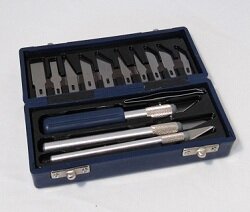
Craft knives: Some polymer clay suppliers sell form making sets, where you can create your own shape cutters. You can also get geometric clay cutters, where the cut is slanted. There are many things that you already have in your home that you can use to cut shapes. Search around to find things you can use. A straw can be very useful for cutting small round shapes, as can the top of a pen. Cane slicers: 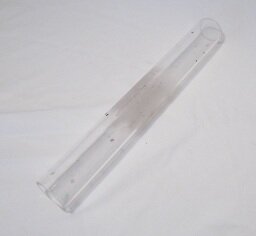
Acrylic rollers: You can get the acrylic rollers in different sizes and shapes. Some are hard , and some are hollow . You can get them square to. The square ones are used to reduce square canes. Clay sticks to the acrylic rollers, so dust the clay with cornstarch before your roll it, or put a piece of paper on top of the clay. You can also get rollers with handles. These are not transparent, and must not be washed with alcohol. I have one, but must admit that this is not one of the polymer clay tools that I use often. So if you need to choose, I would say; go for one without a handle. It is wider and easier to clean. But just because I don't use mine, does not mean that you will not use yours, so pick what suits your purpose most, or buy both. If you cannot afford to buy one, use a glass bottle or a glass. Just be careful so that it does not break. Lucite plates: You can use Lucite plates to roll beads into different shapes. You put the bead under the plate and roll it into the shape you want, depending on how you move the plate, and where you apply pressure. This way you leave no finger- or hand prints on the beads. They are also great when it comes to roll tube beads. I use my patchwork templates for this. That way I have different sizes and shapes to use. You can also use glass plates, like from a photo frame. I would recommend you to put electrical tape around the edges of the glass, though, as they are very sharp. I use bamboo rods for lots of things. They are perfect for glazing beads with liquid polymer clay, as you can spin the beads around when you heat them. They make large holes, though. When making small beads, that may not be what you need. Therefore I also have some mandrels that are very thin, but long enough to bake several beads at the time. There are also fabricated piercing pins and bead racks made especially to bake polymer clay on. You can get those from most suppliers that sell polymer clay tools. There are some brands of texture sheets that I can recommend you to buy, like: Makin's clay texture sheet sets : Studio by Sculpey texture makers: You can see one of these patterns used in this tutorial: Swirl Beads - One Pattern, Three Techniques Scratch-art's Shade Tex rubbing plates: Lisa Pavelka's Texture stamps: Remember to dust your clay with cornstarch or spray it with water, before you press the texture into the clay. That will prevent the clay to stick to the texture plate. If you should forget, don't panic. Simply soap the plate in with dishwasher soap and remove the clay with water. If some still stick, use a small needle to pick it out. See how you can use texture plates and metal leaf in this tutorial: Eye Catching Chinese Brocade Beads Return from Polymer clay tools to Polymer clay basics Leave a comment ,I would love to hear your opinion on this page. Good or bad, it will help me making this Site better. |
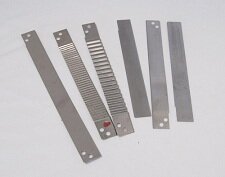
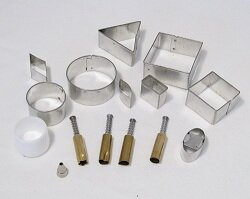
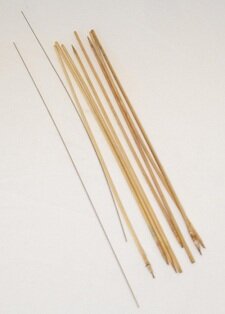 Rods, mandrels and skewers:
Rods, mandrels and skewers:
